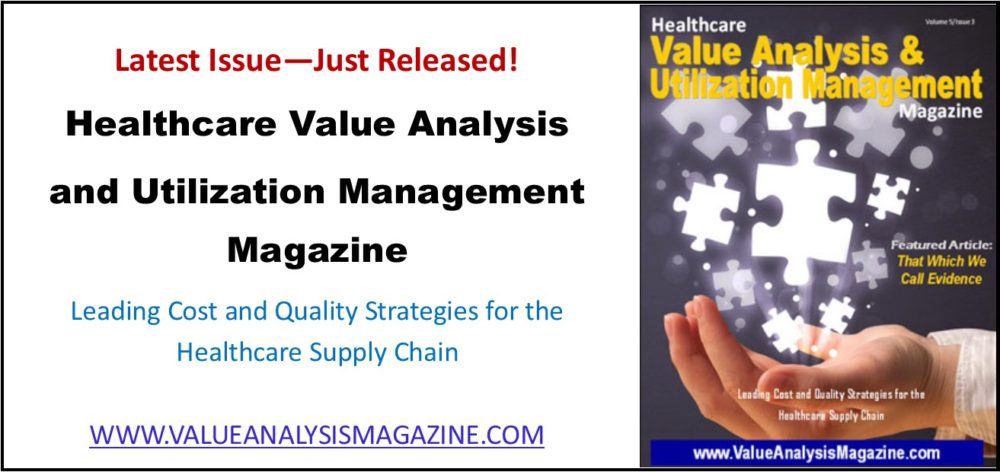James Russell, RN-BC, Value Analysis Facilitator
VCU Health System, Richmond, VA
What do we mean when we talk about Value Analysis projects that focus on utilization? We’re talking about practice change. To a clinician, asking them to change their method of practice can be a bit threatening. “The way they’ve always done it,” has been working just fine in their eyes, so why change something that isn’t broken? Our task, in Value Analysis, is to provide a convincing argument for change that supplies sufficient motivation and reward.
Clinical Evidence
By training, clinicians are scientists, to a great extent. They are trained in a myriad of scientific disciplines from Anatomy and Physiology to Biology and Microbiology to Chemistry and Pharmacy. This training includes a great deal of statistical analyses and a heavy reliance on the scientific method. When seeking to influence a clinician’s practice, use of these tactics can dramatically assist in breaking down barriers and clearing up misunderstandings.
At the Virginia Commonwealth University Health System (VCUHS), the Value Analysis Facilitators (VAFs) rely heavily on the examination of clinical evidence to support proposed change. Our Chief Nursing Officer and Vice President of Patient Care Services, Dr. Deb Zimmerman, has a very predictable line whenever an idea involving practice change is pitched: “What does the evidence show?” It’s become so predictable that others ask it before getting in front of her. How can we convince her that changing the current practice, effecting utilization, will be beneficial? Evidence!
Case Study
A recent example at VCUHS involved Sequential Compression Device (SCD) sleeves. Through networking at a UHC (University HealthSystem Consortium) conference, the VAFs heard about a potentially significant ROI (Return on Investment) by converting from the higher cost thigh-high sleeves to lower cost knee-high sleeves. This ROI was primarily financial, although a clinical component existed. The first step: “What does the evidence show?”
By examining several published clinical studies, a hypothesis was formulated and presented to the clinicians. Chief among their concerns were the proposed change’s effect on DVT/PE (Deep Vein Thrombosis / Pulmonary Emboli) rates. These untoward events are serious and can be potentially fatal and are the reason SCDs are used in the first place. An increase in these clinically dangerous outcomes would be unacceptable and the clinicians (rightly so) would be unwilling to “experiment” and see what happened. They’d need evidence to convince them changing their practice would be safe. The hypothesis therefore became:
Conversion from thigh-high to knee-high SCD sleeves will decrease VCUHS supply costs, increase patient compliance (due to knee-high being more comfortable), and will not adversely affect DVT/PE rates.
Presenting a Value Analysis project in the form of a hypothesis can be very helpful in explaining the rationale for a project and providing measurable benchmarks to follow up on later. In this presentation, the goal of cost savings is not hidden. In order to maintain (or establish) credibility with clinical experts, it is important to be upfront about a project’s goals and projected benefits. Transparency is a popular word in Value Analysis, and rightly so. Decisions involving clinicians should be clear and undisguised, providing both defensibility if needed and inclusion of eclectic opinions and ideas.
There was convincing evidence, from several sources, to show that the use of knee-high vs. thigh-high SCD sleeves showed no statistical difference in DVT/PE rates. Some studies also showed an increase in patient compliance with the knee-high sleeves, as the thigh-high sleeves can be quite uncomfortable. After presentation to many clinicians, the project was approved by most, but not all, and conversion occurred, except in select areas.
Twelve months later, the project’s repercussions were shared with the clinicians. This is an important step in the process. If the clinicians are going to support a practice change, they should be included in the follow up, whatever the outcome. In the SCD project, VCUHS experienced a cost savings that was nearly six-figures and our DVT/PE rates not only didn’t increase, they went down! It is possible that increased patient compliance played a part in this decrease. After presentation of the follow up data, those clinicians who were reluctant to convert at the beginning of the project were convinced of the benefits and agreed to do so. Improving patient outcomes, by decreasing untoward events, can definitely provide compelling motivation for clinicians to change their practice.
Summary
A project like the one described above is the very definition of a win-win. Supply costs are decreased, negative clinical outcomes are decreased, and patient satisfaction improves. Accomplishing all of this, without changing the price of the items being purchased may be different for many Value Analysis programs that are intensely price-focused. As VCUHS’s Director of Materials Management, Timothy Wildt, points out, “Value Analysis will never get away from price negotiations, but you can only lower a price so far. Utilization is where the greater impact can be made.”
A few projects like the one described here can enhance future clinician participation in utilization-based projects. Asking them to change their practice by providing sufficient evidence and motivation will be met with less skepticism and resistance when successful projects can be used as primers. It may even motivate them to generate project ideas on their own and bring them to Value Analysis!
Jim Russell is a Value Analysis Facilitator for Virginia Commonwealth University Health System and has more than 25 years of nursing experience, specializing in critical care and psychiatry. He's been a Staff Nurse, Charge Nurse, Clinical Coordinator, Nurse Manager, Director, and Chief Nursing Officer. He worked for many years in the for-profit community healthcare sector and also has several Academic Medical Centers on his resume. Jim sat for 5 years on the Nursing Advisory Board for a HealthTrust, performing Value Analysis for nursing related products and represented more than 70 hospitals. He is currently on several Advisory Councils and Special Interest Groups for UHC and Novation. When not at work, he can be found rolling around with his hyperactive rescue Husky. You can contact Russell with your questions or comments at jrussell2@mcvh-vcu.edu





